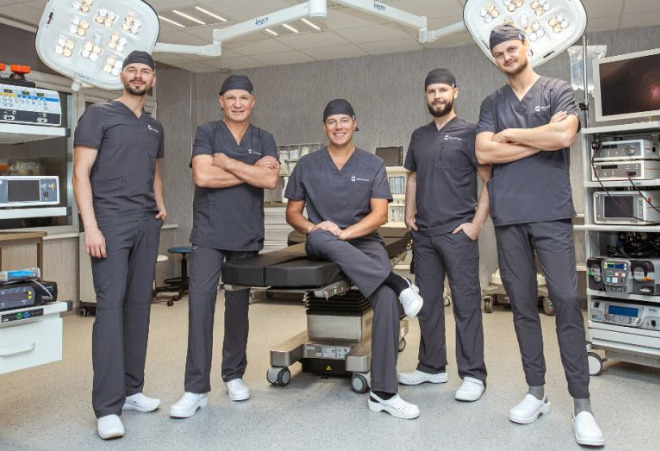
Men and Plastic Surgery: Harmony of Beauty and Health
In the public sphere, there’s a prevailing opinion that plastic surgery is necessary only for women who want to look beautiful, while men are handsome just the way they are. Is that really the case? Or do men also need plastic surgery, not necessarily just for cosmetic reasons? The topic of men and plastic surgery was discussed by plastic and reconstructive surgeons from “Gijos Klinikos” – Mantas Sakalauskas, Giedrius Stankevičius, and Karolis Černauskis.
According to them, plastic surgery is just as beneficial and necessary for men as it is for women. In other words, it’s not an exception but a rule. “In recent years, our society of men is increasingly following the direction set by Western countries, aiming to improve not only in technology but also in self-perception, analysis, health orientation. As a result, there is inevitably more attention to their well-being and appearance. Due to this, a significantly higher interest in plastic surgery among representatives of the strong gender is clearly evident. Statistically, I could estimate that approximately every sixth inquiry comes from men,” stated G. Stankevičius.
Mantas Sakalauskas, a plastic and reconstructive surgeon at “Gijos Klinikos,” noted that the spectrum of surgeries performed on men is quite extensive. “Various facial plastic surgeries are performed on men: upper and lower eyelid surgery, eyebrow lift, rhinoplasty, facial fat transfer, and for older patients – facelift. The most common body plastic surgeries include gynecomastia, liposuction, abdominal plastic surgery for men who have lost a lot of weight, as well as plastic surgery for the chest, thighs, and back. There are indeed many types of surgeries. At one point, penile plastic surgery was very popular, but it didn’t deliver the expected results, and the popularity of these surgeries decreased,” observed M. Sakalauskas.
His colleague, Dr. K. Černauskis, mentioned upper eyelid surgery, removal of enlarged breast glands (gynecomastia surgery), liposuction of excess fat, as well as corrective body surgeries after significant weight loss, such as abdominal plastic surgery, 360° waist plastic surgery, thigh and buttock plastic surgeries, as the most common plastic surgeries performed on men.
According to the specialist, recently, men are actively interested in HD body contouring – liposuction. “With this method, natural muscle contours can be enhanced, giving the body an athletic, sporty appearance. However, men often seek plastic surgery to address health issues. Perhaps the best example would be the gynecomastia surgery, upper eyelid surgery, and surgeries after massive weight loss. After upper eyelid surgery and removal of excess skin, eye irritation, tearing, and vision problems disappear. Gynecomastia – enlarged male breasts – also causes pain, discomfort, and tension. Removing the enlarged breast glands eliminates these symptoms. Patients who have lost a significant amount of weight struggle with excess skin. In such cases, there can be redness, irritation, wounds, signs of infection, and fungal infections in the folds of the skin. When these symptoms are present, and excess skin is removed from any problematic area, patients not only rejoice in their transformed bodies and excellent aesthetic results but also experience relief from previous complaints,” stated the plastic and reconstructive surgeon.
Since plastic surgery centers have traditionally been visited more by women, the question naturally arises whether performing plastic surgeries on men is more challenging than on women. The answer is no. Men only have firmer tissues and better blood circulation, which can lead to slightly more bleeding, but it certainly doesn’t cause significant problems. The postoperative period is generally similar for all genders. There are cases where men are inclined to communicate less or share their emotions less, leading to them experiencing pain when it’s not necessary,” reasoned M. Sakalauskas, a plastic and reconstructive surgeon at “Gijos Klinikos.”
Stankevičius also noted that men often have more harmful habits and sometimes have a harder time following the prescribed regimen after surgery. “These specific factors do indeed significantly affect the course of the postoperative period, but the surgeries themselves take a bit longer mainly because men’s body mass and structure are generally larger than women’s,” observed G. Stankevičius.
Speaking about the future prospects of plastic surgery, Mantas Sakalauskas, a plastic and reconstructive surgeon at “Gijos Klinikos,” stated that plastic surgery is moving towards a more natural path. “Less and less do people want to fundamentally change a person’s features, body composition, or overall appearance. Now, plastic surgery is mainly aimed at restoring lost forms, correcting age-related changes, and thus inevitably becomes an integral part of life. The clear direction is towards moving towards self-confidence. The greater the trust in the plastic surgeon and the greater the self-confidence,” said G. Stankevičius.
According to M. Sakalauskas, the future of plastic surgeries is promising, and more and more people are likely to choose plastic surgeries in the future. “With the improvement of the country’s economy, these surgeries become accessible to a larger part of society, and let’s not even talk about the fact that everyone wants to look and feel good. My goal as a plastic and reconstructive surgeon is to achieve the most natural, subtle, and satisfying result for the patient,” he added.
This sentiment was echoed by K. Černauskis. “Trends are always changing and will continue to change, but that’s natural. Previously, artificial and unnatural standards prevailed, but now people simply want to feel healthy, confident, address and correct existing problems that prevent them from feeling truly good. And for men, I want to reiterate that plastic surgery is completely normal,” concluded the plastic and reconstructive surgery specialist.
The article was first published on 03.06.2023 in the Lithuanian version of the fashion magazine A-ZET. You can find the original version here.